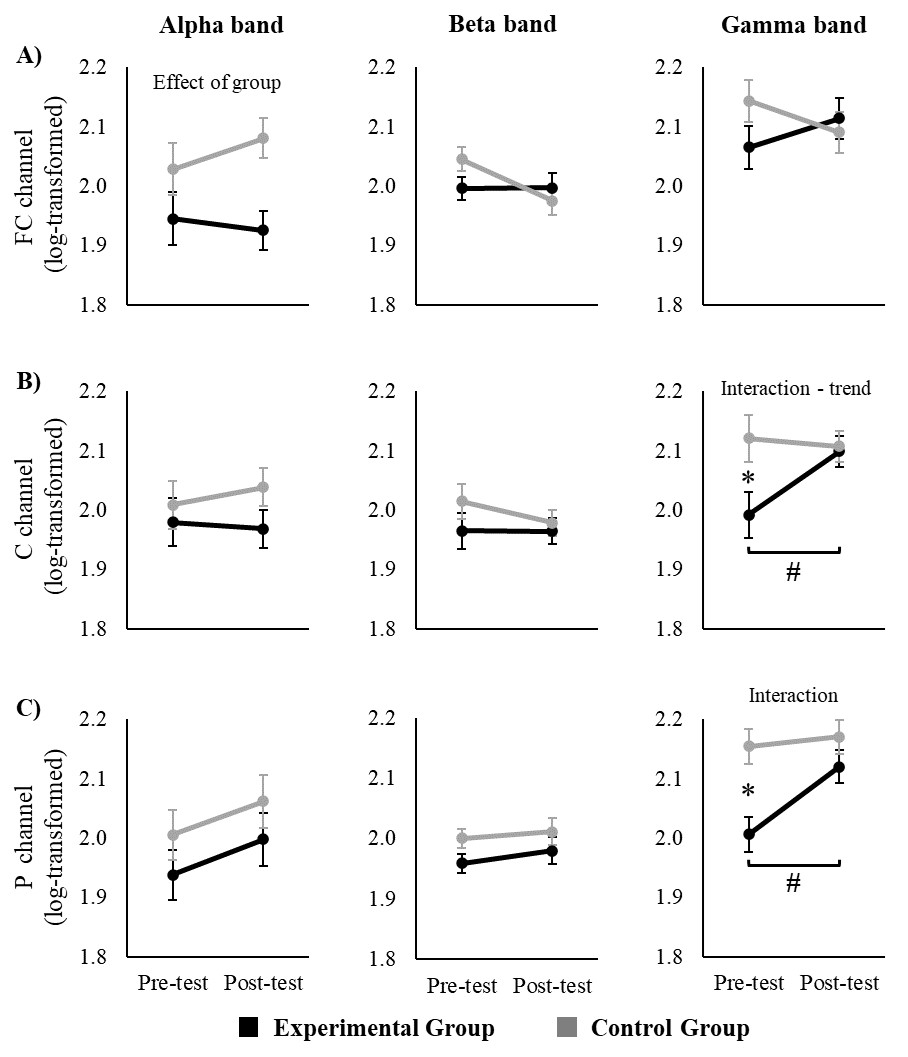Objective: We aimed to investigate the effects of a single session of moderate aerobic exercise on electrocortical activity during walking in people with PD.
Background: Acute aerobic exercise in people with Parkinson’s disease (PD) reduces PD motor signals (e.g., tremor and bradykinesia) and improves executive functions, and cortical and subcortical activation patterns in resting states [1–3]. However, it remains unclear whether acute exercise can improve brain cortical activity during walking in people with PD.
Method: 34 individuals with PD were randomly assigned to two groups: Experimental and Control. Both groups performed an aerobic exercise session on a cycle ergometer that lasted 40-min. For the Experimental Group, the exercise intensity was maintained between 65 and 70% of the maximum heart rate, while for the Control Group, the heart rate was kept within 5% of the resting heart rate. Participants were invited to walk along a 26.8-m circuit for 30s at their usual speed – five trials in each period (pre- and post-exercise). Brain activity and gait parameters were analyzed using mobile electroencephalography (EEG) and an electronic carpet, respectively. EEG absolute power from alpha, beta, and gamma bands in FC, C, and P channels (related to motor planning, motor execution, and sensorimotor processing, respectively) were calculated. Since EEG data violated the assumption of normal distribution, the data were log-transformed and analyzed by two-way ANOVA with group and time as factors, with repeated measures for time.
Results: ANOVA revealed group-by-time interaction for Gamma band at the C (F1,29=3.69, p=0.06, trend) and the P channel (F1,29=4.80, p=0.04) (Figure 1). Post hoc tests showed that Experimental Group had lower Gamma power in the C (p=0.04) and P channels (p<0.01) during walking at pre- than Control Group, but not in the post-exercise as power increased for the Experimental Group at both channels. There was no group-by-time interaction in the gait parameters.
Conclusion: A single section of exercise increased the Gamma power at the C and P channels, which could be interpreted as an improvement in motor control and sensorimotor integration of PD patients [4]. However, these results should be interpreted with caution because of group differences at the pre-exercise and that cortical activity was not accompanied by changes in gait parameters.
References: [1] Alberts JL, Phillips M, Lowe MJ, Frankemolle A, Thota A, Beall EB, et al. Cortical and motor responses to acute forced exercise in Parkinson’s disease. Park Relat Disord. 2016;24:56–62.
[2] Ridgel AL, Peacock CA, Fickes EJ, Kim CH. Active-assisted cycling improves tremor and bradykinesia in Parkinson’s disease. Arch Phys Med Rehabil. 2012;93(11):2049–54.
[3] Ridgel AL, Kim C-H, Fickes EJ, Muller MD, Alberts JL. Changes in executive function after acute bouts of passive cycling in Parkinson’s disease. J Aging Phys Act. 2011;19(2):87–98.
[4] Orcioli-Silva D, Vitório R, Nóbrega-Sousa P, Beretta VS, Conceição NR da, Oliveira AS, et al. Cortical Activity Underlying Gait Improvements Achieved With Dopaminergic Medication During Usual Walking and Obstacle Avoidance in Parkinson Disease. Neurorehabil Neural Repair. 2021;35(5):406-418..
To cite this abstract in AMA style:
D. Orcioli-Silva, R. Vitório, V. Beretta, A. Oliveira, N. Conceição, P. Nóbrega-Sousa, P. Santos, L. Gobbi, J. Barela. A single session of aerobic exercise increase EEG gamma band in the motor and sensorimotor areas during usual walking in people with Parkinson’s disease [abstract]. Mov Disord. 2023; 38 (suppl 1). https://www.mdsabstracts.org/abstract/a-single-session-of-aerobic-exercise-increase-eeg-gamma-band-in-the-motor-and-sensorimotor-areas-during-usual-walking-in-people-with-parkinsons-disease/. Accessed December 12, 2025.« Back to 2023 International Congress
MDS Abstracts - https://www.mdsabstracts.org/abstract/a-single-session-of-aerobic-exercise-increase-eeg-gamma-band-in-the-motor-and-sensorimotor-areas-during-usual-walking-in-people-with-parkinsons-disease/

